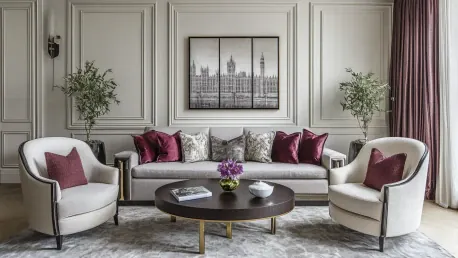As British interior design trends continue to evolve, their impact on American homes has become increasingly evident. The transatlantic influence has brought a fresh approach to interior decoration, marked by a distinct combination of warmth, coziness, and creative expression. This fusion of styles has led to a growing appreciation for certain design elements that are quintessentially British, offering a unique perspective on how spaces can be both functional and aesthetically pleasing.
Asymmetry and Creative Expression
Embracing the Charm of Imperfection
The trend of embracing asymmetry in interiors has gained notable traction among designers and homeowners alike. This design philosophy, championed by figures such as Kelly Hoppen and Rupert Cunningham, emphasizes the beauty found in spaces that deviate from perfect coordination. By allowing rooms to evolve organically over time, akin to the classic English country house, asymmetry fosters a sense of individuality and layered history. Instead of striving for a picture-perfect arrangement, this approach celebrates the character and personality that come from a more spontaneous, less structured design.
Asymmetry in interior design encourages flexibility and creativity, as it opens the door to unconventional layouts and eclectic combinations. This trend resonates with the idea that homes should reflect the unique tastes and experiences of their occupants, rather than adhering to rigid design rules. The eclectic mix of furnishings and decor pieces creates a dynamic environment where each element tells a part of the home’s story.
The Impact on American Interiors
The influence of asymmetry has begun to permeate American homes, where people are increasingly drawn to spaces that feel lived-in and authentic. The appeal of this trend lies in its ability to make interiors feel more personal and inviting, as opposed to overly styled or contrived. By incorporating asymmetrical elements, American homeowners can create rooms that are both visually interesting and deeply rooted in their own histories. This approach aligns with a growing desire to move away from cookie-cutter designs and towards spaces that celebrate individuality.
The adoption of asymmetry also extends to the arrangement of art and decor. Rather than adhering to traditional symmetry, homeowners are experimenting with varied heights, sizes, and styles to create unique focal points. This trend encourages a more relaxed and approachable aesthetic, transforming American interiors into spaces that are rich with character and charm.
The Art of Layering
Depth and Character in Layered Spaces
Layered interiors are celebrated for their ability to infuse rooms with depth and character. This trend involves the careful combination of patterns, colors, and mix-matched furniture to achieve a harmonious yet dynamic environment. Designers such as Ailsa Connery and Emma Sims-Hilditch have highlighted the timeless appeal of layered English country interiors, which evolve organically with contributions from each occupant. The iterative and collaborative process of layering is key to creating spaces that feel cohesive and inviting.
Lighting plays a fundamental role in enhancing the layered look, adding depth and form to the various elements within a room. The use of multiple light sources, such as table lamps, floor lamps, and wall sconces, helps to create a warm and welcoming atmosphere. Additionally, incorporating textiles like rugs, throw blankets, and cushions adds another dimension to the design, contributing to the overall sense of comfort and coziness.
Transatlantic Influence
The concept of layering has found a receptive audience in America, where homeowners are increasingly drawn to the richness and complexity that this approach brings to interiors. By embracing the art of layering, Americans are able to create spaces that feel more personalized and thoughtfully curated. This trend encourages experimentation with different textures, patterns, and finishes, resulting in rooms that are both visually appealing and deeply engaging.
Layering also provides an opportunity to incorporate a variety of furniture styles, from vintage pieces to contemporary designs. This eclectic mix adds to the sense of history and personality within a space, making it feel unique and reflective of the homeowner’s individual taste. As the trend continues to gain momentum, American interiors are expected to become more diverse and expressive, moving away from uniformity and towards a more nuanced and layered aesthetic.
Vibrant Colors and Bold Statements
A Departure from Neutrals
In recent years, British interiors have seen a shift away from neutral palettes in favor of rich, bold hues. This trend is characterized by the use of vibrant colors to shape the atmosphere and emotion of a space. Designers like Brigitta Freund and Darren Price note that this resurgence of color and pattern, especially through wallpaper, represents a move away from the plain backgrounds that have dominated interior design for some time. By embracing color, homeowners are able to inject energy and personality into their spaces, making them feel more lively and engaging.
The use of vibrant colors extends beyond just walls and wallpapers; it also influences furniture, decor, and accessories. Bold, colorful pieces can serve as focal points within a room, drawing the eye and creating a sense of excitement. This trend encourages homeowners to be fearless in their use of color, experimenting with unexpected combinations and embracing the impact that bold hues can have on the overall feel of a space.
American Adoption of Vibrancy
The influx of vibrant colors into American interiors represents a bold departure from the more subdued palettes that have long been popular in the United States. This trend is appealing to those who seek to create more dynamic and inviting living spaces. By incorporating rich, deep colors, American homes can achieve a sense of warmth and coziness, mirroring the inviting atmosphere found in many British interiors.
Additionally, the use of bold colors allows for greater expression of personal style. Homeowners can choose hues that resonate with their tastes and preferences, creating spaces that feel uniquely their own. This shift towards vibrant colors is also reflective of a broader movement towards individuality and self-expression in interior design, where the focus is on creating spaces that are both beautiful and deeply personal.
The Power of Greenery
Celebrating Nature Indoors
The incorporation of leafy greens and botanicals in interior design remains a powerful trend that continues to gain popularity. Verdure-inspired prints and botanical elements on wallpaper, textiles, and decor pieces celebrate a deep connection to nature, as highlighted by designers like Ailsa Connery. The use of natural motifs brings a sense of calm and tranquility to interiors, creating spaces that feel fresh and invigorating.
Alexander Hoyle advocates for the inclusion of actual plants within interiors, noting their ability to add life and color to spaces. Plants not only enhance the visual appeal of a room but also contribute to improved air quality and overall well-being. The presence of greenery can soften the lines of furniture and architecture, creating a more organic and harmonious environment.
Greenery’s Growing Presence in America
The trend of incorporating botanical elements has been warmly embraced by American homeowners, who recognize the benefits of bringing nature indoors. The use of verdure-inspired prints and decor adds a touch of natural beauty to interiors, making them feel more inviting and serene. This trend aligns with a growing awareness of the importance of biophilic design, which emphasizes the connection between humans and nature.
In addition to decorative elements, the inclusion of live plants has become increasingly popular in American homes. Plants like succulents, ferns, and potted trees are being used to create indoor gardens and green spaces that promote relaxation and well-being. The presence of greenery in the home adds a dynamic element that evolves over time, contributing to the sense of growth and change within a space.
A Transatlantic Evolution
As British interior design trends evolve, their influence on American homes becomes increasingly clear. This transatlantic exchange has ushered in a fresh approach to decorating, characterized by a mix of warmth, coziness, and artistic flair. This blending of styles has encouraged a deeper appreciation for design elements that are distinctly British, offering a unique lens on making spaces both functional and visually engaging. Elements like vintage furniture, rich textiles, and eclectic patterns not only add character but also create inviting environments that feel personal and lived-in. British design often emphasizes sustainability and the use of natural materials, which resonates with the growing interest in eco-friendly living in America. Moreover, the emphasis on comfort and tradition in British decor aligns well with the American desire for homes that serve as retreats from the outside world. This cross-cultural influence enriches our understanding of interior design, showing that a well-decorated home can be both chic and comfortable.









